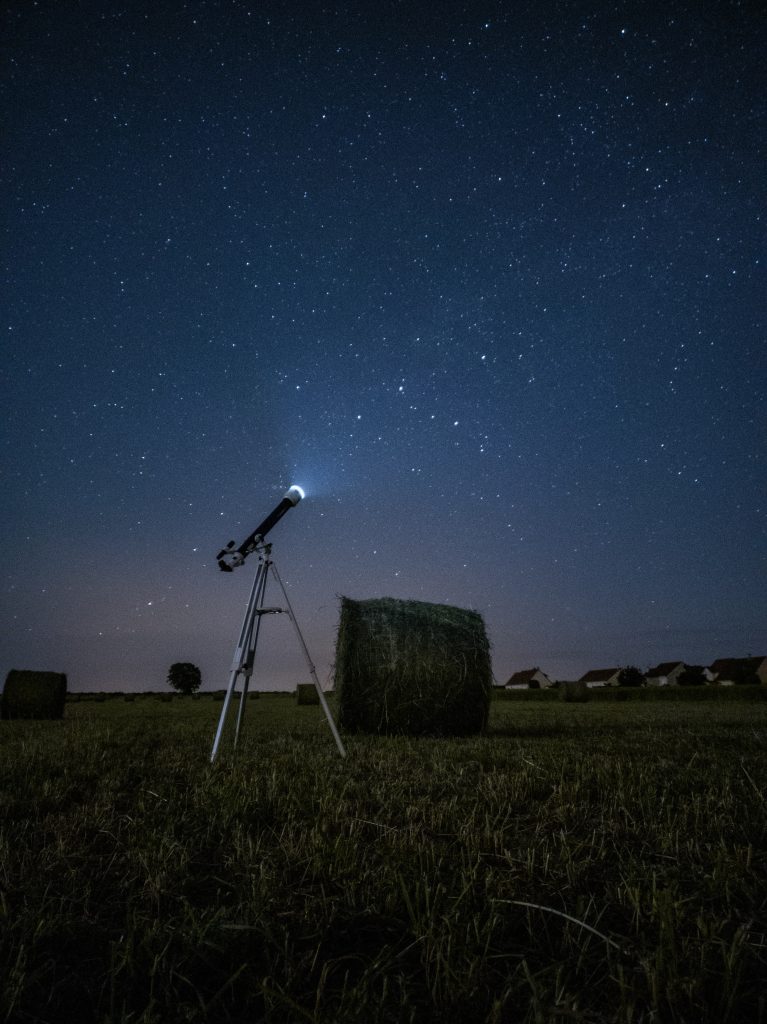“Have you ever wondered about the difference between a refractor and a compound telescope? Well, let me give you a friendly explanation. A refractor telescope is known for its simplicity and elegance. It uses lenses to gather and focus light, allowing you to have clear and crisp views of celestial objects. With a refractor telescope, you’ll enjoy sharp images, especially when observing objects in our solar system like the moon or planets.”
“On the other hand, a compound telescope, also known as a catadioptric telescope, combines both lenses and mirrors to achieve its compact design. It offers a versatile experience, allowing you to observe various astronomical objects from galaxies to close-up views of the moon. The compound telescope utilizes a combination of mirrors and lenses, which enables it to have a long focal length and a compact tube.”
So, whether you prefer the classic elegance of a refractor telescope or the versatility of a compound telescope, both options offer incredible views of our vast universe. Happy stargazing!
Overall Comparison
Definition of a Refractor Telescope
A refractor telescope is a type of telescope that utilizes lenses to collect and focus light. It consists of a long, cylindrical tube with a lens at the front (objective lens) and an eyepiece at the back. The objective lens gathers the incoming light and bends it to form an image, which is then magnified by the eyepiece for observation. Refractor telescopes have been used for centuries and are known for their simplicity and durability.
Definition of a Compound Telescope
A compound telescope, also known as a catadioptric telescope, combines both lenses and mirrors to gather and focus light. It features a combination of lenses and mirrors that allows for a more compact design compared to refractor or reflector telescopes. Compound telescopes typically have a corrector plate or lens at the front, which corrects for optical aberrations, a primary mirror at the back, and an eyepiece for observation.
Key Distinctions
The key distinction between refractor and compound telescopes lies in their design and optical components. Refractor telescopes use only lenses for gathering and focusing light, while compound telescopes utilize a combination of lenses and mirrors. This difference in design affects various aspects of their performance, including image quality, light gathering ability, and portability.
Design and Construction
Refractor Telescope Design
Refractor telescopes have a straightforward design and construction. They consist of a tube with a lens at one end (objective lens) and an eyepiece at the other. The objective lens gathers light and focuses it onto a focal point inside the telescope, where the eyepiece magnifies the image for observation. Refractor telescopes are typically long and narrow, with the objective lens positioned at the front of the tube.
Compound Telescope Design
The design of compound telescopes is more complex due to the inclusion of mirrors in addition to lenses. They typically have a corrector plate or lens at the front, which helps correct for optical aberrations, a primary mirror at the back that reflects the light, and an eyepiece for observation. The combination of lenses and mirrors allows compound telescopes to achieve a more compact design compared to refractors or reflectors.
Lens Arrangement
In refractor telescopes, the lenses are arranged in a sequential manner, with the objective lens at the front and the eyepiece at the back. The objective lens gathers and focuses the light, while the eyepiece magnifies the resulting image. This straightforward arrangement simplifies the optical path of the telescope.
Mirror Arrangement
In compound telescopes, the mirrors are arranged in a way that allows for a folded optical path. The light entering the telescope is first directed to the primary mirror at the back, which reflects it towards the corrector plate or lens at the front. This arrangement allows for a more compact design, making compound telescopes more portable and easy to handle.

Optical Components
Refractor Telescope Optics
Refractor telescopes rely solely on lenses for their optical components. The objective lens is responsible for gathering and focusing the incoming light, while the eyepiece provides the magnification for observing the image. The quality of the lenses greatly influences the overall performance and image quality of a refractor telescope.
Compound Telescope Optics
Compound telescopes combine both lenses and mirrors in their optical components. The corrector plate or lens at the front helps correct for optical aberrations, such as chromatic aberration and spherical aberration. The primary mirror reflects the light towards the corrector plate or lens, which then focuses it onto the eyepiece. The quality of both the lenses and mirrors in a compound telescope plays a significant role in determining its optical performance.
Objective Lens
The objective lens in a refractor telescope is a crucial component responsible for gathering and focusing light. It is typically a large, convex lens positioned at the front of the telescope. The quality and construction of the objective lens greatly affect the image quality, with high-quality lenses producing clearer and sharper images.
Eyepiece
The eyepiece is the component that provides the magnification for observing the image formed by the objective lens. It is positioned at the back of the telescope and can be interchanged to achieve different levels of magnification. The quality of the eyepiece affects the overall clarity and resolution of the observed image.
Light Gathering and Magnification
Refractor Telescope
Refractor telescopes are known for their excellent light gathering ability due to the large objective lens. The objective lens captures a significant amount of light and focuses it onto the eyepiece, resulting in bright and detailed observations. However, the light gathering ability of refractor telescopes is limited by the size of the objective lens.
Compound Telescope
Compound telescopes also have a good light gathering ability, thanks to the combination of lenses and mirrors. The corrector plate or lens helps capture and focus the incoming light, while the primary mirror reflects it towards the eyepiece. The addition of mirrors allows compound telescopes to achieve a more compact design without compromising on light gathering capabilities.
Light Gathering Ability
In terms of light gathering ability, both refractor and compound telescopes are capable of capturing a sufficient amount of light for observing celestial objects. However, the larger the objective lens or corrector plate, the greater the ability to gather light, resulting in brighter and more detailed images.
Magnification Power
Both refractor and compound telescopes offer various levels of magnification through interchangeable eyepieces. The magnification power depends on the combination of the objective lens or corrector plate and the eyepiece used. Higher magnification allows for closer observation of celestial objects, but it may also result in a decrease in image brightness and clarity.

Image Quality
Refractor Telescope
Refractor telescopes are known for producing high-quality images with good contrast and clarity. The absence of mirrors in the optical path reduces the chances of optical aberrations, resulting in sharper and more detailed images. However, refractors are prone to chromatic aberration, which causes color fringing around objects, especially at high magnification levels.
Compound Telescope
Compound telescopes are designed to minimize optical aberrations, including chromatic aberration and spherical aberration. The inclusion of mirrors helps correct for these aberrations, resulting in improved image quality compared to refractors. The corrector plate or lens at the front of the telescope plays a crucial role in reducing aberrations and enhancing overall image clarity.
Chromatic Aberration
Chromatic aberration is a common optical aberration that occurs in refractor telescopes. It causes different wavelengths of light to focus at different points, resulting in color fringing around objects. This aberration is caused by the dispersion of light as it passes through the lenses. Some refractors may include additional elements, such as special glass or coatings, to minimize chromatic aberration.
Spherical Aberration
Spherical aberration occurs when light rays passing through different parts of a lens or mirror do not converge at a single point. This results in a decrease in image sharpness and clarity. Compound telescopes with their combination of lenses and mirrors are designed to minimize spherical aberration, producing sharper images compared to refractors.
Portability and Ease of Use
Refractor Telescope
Refractor telescopes are generally more portable and easy to use compared to compound telescopes. They tend to be lightweight and have a simple design, making them easier to set up and transport. Refractors also require less maintenance since they do not have moving parts like compound telescopes.
Compound Telescope
Compound telescopes, while not as portable as refractors, offer a more compact design that makes them easier to transport compared to reflector telescopes. The folded optical path achieved through the arrangement of mirrors allows for a shorter overall length, making compound telescopes more manageable. However, they tend to be heavier due to the inclusion of mirrors and require more careful handling.
Weight and Size
Refractor telescopes are typically lighter and more compact compared to compound telescopes. The absence of mirrors and the simplicity of their design contribute to their lightweight nature. Compound telescopes, while more portable than reflector telescopes, are generally heavier due to the inclusion of mirrors and other optical components.
Assembly and Operation
Both refractor and compound telescopes are relatively easy to assemble and operate. Refractor telescopes have a simple design, making them intuitive to set up and use. Compound telescopes may require more careful handling during assembly due to the inclusion of mirrors, but once set up, they operate in a similar manner to refractors.

Cost and Affordability
Refractor Telescope
Refractor telescopes can vary significantly in terms of cost and affordability. Entry-level refractors are often more affordable and targeted towards beginner astronomers. However, higher-quality refractors with larger objective lenses can be quite expensive. The price range for refractor telescopes varies depending on factors such as the size and quality of the lenses.
Compound Telescope
Compound telescopes generally tend to be more expensive compared to refractors. The combination of lenses and mirrors in their design contributes to higher manufacturing costs. However, the price range for compound telescopes also varies depending on factors such as the quality and size of the optical components.
Price Range
The price range for both refractor and compound telescopes can vary widely. Entry-level refractor telescopes typically fall in the lower price range, making them more accessible to beginners. On the other hand, high-quality compound telescopes with advanced optics can be more expensive, catering to intermediate and advanced astronomers.
Additional Accessories
Both refractor and compound telescopes can be equipped with additional accessories to enhance their functionality and ease of use. Common accessories include tripod mounts, finderscopes, filters, and motorized mounts for automated tracking. The availability and cost of these accessories vary depending on the telescope model and brand.
Applications and Focus Areas
Refractor Telescope
Refractor telescopes are widely used for various astronomical observations, including observing celestial objects such as the Moon, planets, stars, and galaxies. Their straightforward design and good image quality make them suitable for beginners and casual astronomers. Refractors are also popular among nature enthusiasts and birdwatchers due to their versatility.
Compound Telescope
Compound telescopes are commonly used for observing celestial objects, particularly deep-sky objects such as nebulae and galaxies. Their design allows for a more compact size without compromising on image quality. Compound telescopes are also popular among astrophotographers due to their ability to capture detailed images of faint celestial objects.
Observing Celestial Objects
Both refractor and compound telescopes are capable of observing a wide range of celestial objects. The choice of telescope often depends on personal preferences, budget constraints, and the specific objects or phenomena one wishes to observe. Refractors are well-suited for observing the Moon, planets, and stars, while compound telescopes excel at capturing faint deep-sky objects.
Astrophotography
Both refractor and compound telescopes can be used for astrophotography, capturing stunning images of celestial objects. Refractor telescopes are popular for lunar and planetary photography, thanks to their crisp image quality and lower susceptibility to aberrations. Compound telescopes are preferred for capturing deep-sky objects, as their design helps gather more light for imaging fainter objects.
Target User Group and Experience Level
Refractor Telescope
Refractor telescopes are suitable for a wide range of users, from beginner astronomers to more experienced observers. Their simple design and ease of use make them ideal for beginners who are just starting their journey into astronomy. However, higher-quality refractors can also cater to intermediate and advanced astronomers looking for sharper images and better performance.
Compound Telescope
Compound telescopes are often favored by intermediate and advanced astronomers due to their advanced optics and versatility. While they may require a bit more knowledge and experience to handle, their compact design and high-performance capabilities make them a good choice for users looking to expand their observation capabilities.
Beginner Astronomers
Both refractor and compound telescopes can be suitable for beginner astronomers, depending on their preferences and budget. Entry-level refractors offer an affordable and straightforward introduction to astronomy, while compound telescopes provide more advanced features and capabilities for users who are willing to invest in a higher-quality instrument.
Intermediate/Advanced Astronomers
Intermediate and advanced astronomers may lean towards compound telescopes for their enhanced optical performance and more extensive observation capabilities. The ability to observe faint deep-sky objects and engage in astrophotography makes compound telescopes an attractive option for those looking to explore advanced aspects of astronomy.
Conclusion
Choosing the right telescope ultimately depends on your considerations, preferences, and personal rationale. Refractor telescopes offer simplicity, durability, and good image quality, making them suitable for beginner to intermediate users. Compound telescopes, on the other hand, provide more advanced optics, compact design, and versatility, catering to intermediate to advanced astronomers. Assessing factors such as the desired observation targets, ease of use, portability, and budget will help guide your decision in selecting the perfect telescope for your astronomical journey.











